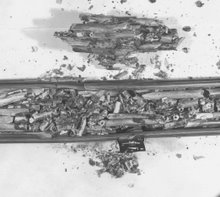Inasmuch as my theme is regulation by myth, I am placing the following into this blog.
A.Word.A.Day
with Anu Garg
mythologem
PRONUNCIATION:
(mi-THOL-uh-jem)
MEANING:
noun: A basic theme of a myth, for example, revenge, honor, betrayal, etc.
ETYMOLOGY:
From Greek mythologema (mythical narrative), from mythologein (to tell mythical tales), from mythos (myth) + -logos (word or speech).
USAGE:
"Another way to see the whole picture is through the symbol and mythologem of land and its specific manifestation in place."Christa Walck; Healing the Divided Mind; Organization & Environment (Thousand Oaks, California); Jun 2004.
Friday, November 21, 2008
Sunday, November 16, 2008
NSF Proposal 0500015 Hydrogen production
I'm just keeping track of this NSF work.
Your NSF Proposal 0500015
Date:
11/16/2008 11:49:01 A.M. Mountain Standard Time
From:
Bobleyse
Reply To:
To:
cta2@cornell.edu, wing.tsang@nist.gov
CC:
aortega@nsf.gov, tbergman@nsf
Gentlemen:
I have the Power Point slides that Wing Tsang e-mailed and I thank you for those.
Slide 5 depicts boiling modes. Are the photographs of boiling in your apparatus? I saw no provisions for that in your proposal or in the subsequent Power Point slides. Slide 5 includes nucleate and film boiling plots: Please tell me the units for the ordinate. I presume that the fluid was methanol and the system pressure was about one atmosphere. I also presume that the surface temperature was measured with an interior thermocouple.
Was fouling of any of the heat transfer elements observed, if so, how much?
Please tell me about the operating efficiency. As a first cut at this, what was the power consumption of the heat transfer element? I would like to see a plot of watts per cubic centimeter of hydrogen (ordinate) and hydrogen production rate (abscissa) for both methanol and ethylene glycol.
Thank you for your cooperation, and I will likely have further questions. I am attaching your Power Point file for the convenience of the NSF addressees.
Bob
Robert H. Leyse
And, here is SLIDE 5, Click on it to enlarge.

Your NSF Proposal 0500015
Date:
11/16/2008 11:49:01 A.M. Mountain Standard Time
From:
Bobleyse
Reply To:
To:
cta2@cornell.edu, wing.tsang@nist.gov
CC:
aortega@nsf.gov, tbergman@nsf
Gentlemen:
I have the Power Point slides that Wing Tsang e-mailed and I thank you for those.
Slide 5 depicts boiling modes. Are the photographs of boiling in your apparatus? I saw no provisions for that in your proposal or in the subsequent Power Point slides. Slide 5 includes nucleate and film boiling plots: Please tell me the units for the ordinate. I presume that the fluid was methanol and the system pressure was about one atmosphere. I also presume that the surface temperature was measured with an interior thermocouple.
Was fouling of any of the heat transfer elements observed, if so, how much?
Please tell me about the operating efficiency. As a first cut at this, what was the power consumption of the heat transfer element? I would like to see a plot of watts per cubic centimeter of hydrogen (ordinate) and hydrogen production rate (abscissa) for both methanol and ethylene glycol.
Thank you for your cooperation, and I will likely have further questions. I am attaching your Power Point file for the convenience of the NSF addressees.
Bob
Robert H. Leyse
And, here is SLIDE 5, Click on it to enlarge.

So, I corrected the above request as follows:
Fwd: Your NSF Proposal 0500015
Date:
11/16/2008 12:53:17 P.M. Mountain Standard Time
From:
Bobleyse
Reply To:
To:
cta2@cornell.edu, wing.tsang@nist.gov
CC:
aortega@nsf.gov, tbergman@nsf.gov, rwellek@nsf.gov, phelan@asu.edu
Correction: In the following sentence, please replace "watts" with "watt-seconds"
I would like to see a plot of watts per cubic centimeter of hydrogen (ordinate) and hydrogen production rate (abscissa) for both methanol and ethylene glycol.
Some generic expressions of praise
Read these and laugh so hard that you can't get to sleep!
His discoveries in the late 1980s and early 1990s alone should have earned him a solid place in the history of experimental heat transfer, but in the years since then he has made these a foundation for several fantastic applications and further investigations..
Luck plays a role in his work, but more important is the series of uninhibited approaches that have baffled the "experts."
This award is presented annually for outstanding scientific achievements in experimental heat transfer that occurred in the past 20 years.
The annual award is for outstanding basic research in experimental heat transfer.
He won the 2008 Heat Transfer Achievement Award for Breakthrough Research.
The investigator could have been at the Generic University School of Engineering when he received the 2008 Humanitarian Award from the American Generic Association.
His discoveries in the late 1980s and early 1990s alone should have earned him a solid place in the history of experimental heat transfer, but in the years since then he has made these a foundation for several fantastic applications and further investigations..
Luck plays a role in his work, but more important is the series of uninhibited approaches that have baffled the "experts."
This award is presented annually for outstanding scientific achievements in experimental heat transfer that occurred in the past 20 years.
The annual award is for outstanding basic research in experimental heat transfer.
He won the 2008 Heat Transfer Achievement Award for Breakthrough Research.
The investigator could have been at the Generic University School of Engineering when he received the 2008 Humanitarian Award from the American Generic Association.
Subscribe to:
Comments (Atom)
